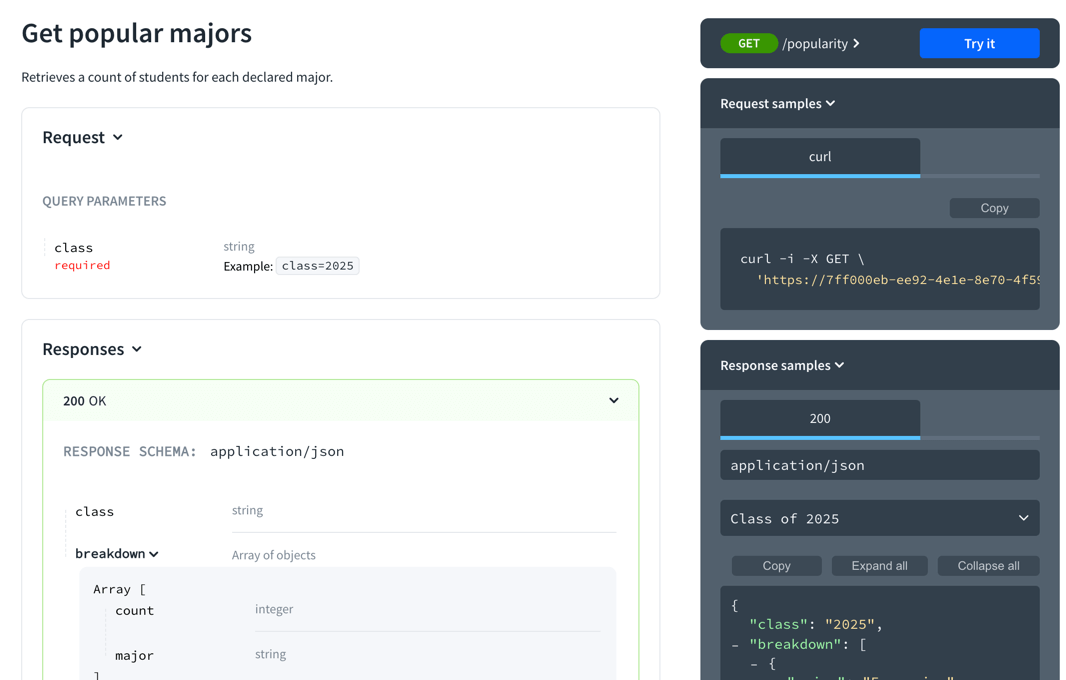At Redocly, we've pointed new hires to 3rd-party OpenAPI content, including the specification itself, and various tutorials freely available online. At the 90-days marker, most people have not completed even half of the tutorials.
Amanda, a student at Claremont McKenna College (CMC), my alma mater, began a 90-day internship in product management at Redocly last week. The internship is a total of 90 calendar days which is about 60 work days. She'll want to hit the ground running with no month-long tutorials to learn OpenAPI. She has a non-technical background and is interested in adding technical skills. APIs are a great place to start.
Can we train Amanda to learn the basics of OpenAPI in a day or two max?
Amanda is coming without prior knowledge. Does she know what an API is, YAML, Git, the command-line, or OpenAPI? No.
This blog post outlines exactly what I'll have Amanda do to get acclimatized to APIs.
I hear and I forget. I see and I remember. I do and I understand.
- Confucius
We'll rely on some ancient wisdom to make sure she does things and isn't only reading. Where reading is involved, there should be some corresponding "doing" exercise.
- Read my blog post about APIs
- Homework: Explain what an API is to someone else in your own words.
- Take Redocly's YAML essentials course (the exercises are built-in)
- Install VS Code.
If you've made it this far, you can explain what an API is. Now, let's use an API.
Open the VS Code terminal. 
The cursor of the command line may look something like the following. 
The following command uses a tool, curl, that makes HTTP (and API) requests. Fun fact, the tool is older than Amanda, and is maintained by the original creator, Daniel Stenburg.
Copy the following curl command.
curl -X GET \
'https://7ff000eb-ee92-4e1e-8e70-4f59d7ca69ad.remockly.com/popularity?class=2025'The server is https://7ff000eb-ee92-4e1e-8e70-4f59d7ca69ad.remockly.com.
The path is /popularity.
The query parameter is class with a value of 2025. A question mark (?) typically separates the path from query parameters.
Paste it into the VS code terminal and press return.
The following is a screenshot of the response.

🎉 Woo hoo! You've sent your first API request.
While OpenAPI is the predominant standard for describing HTTP APIs, the step above is the way most APIs are actually described today.
Even though OpenAPI (formerly known as Swagger) has been around for a decade, it takes time for organizations to adopt new technology. And it takes reasons.
Isn't the example above good enough?
It is good enough for some simple cases, but as the schema of an API gets more complex, and as an API has more paths (also known as endpoints) and operations, it becomes increasingly difficult to describe and organize.
In addition, OpenAPI isn't used only for documentation. It is used to generate mock servers (that's how the API you tested above is powered by Redocly's mock server). It is used to generate code samples. It is used to do contract and security-based testing. And to generate server and client code.
OpenAPI is a structured document in YAML or JSON. In this tutorial, we'll use YAML.
The following is an excerpt of the OpenAPI description of the CMC API.
openapi: 3.1.0
info:
title: CMC Majors
version: v1
paths:
/popularity:
get:
operationId: getPopularMajors
summary: Get popular majors
description: Retrieves a count of students for each declared major.
parameters:
- name: class
in: query
required: true
schema:
type: string
example: "2025"
responses:
'200':
description: OK
content:
application/json:
schema:
type: objectA quick review of the snippet above reveals there is some structure to the file.
We use the term "type" to mean the type of complex data being described (as opposed to scalar data). This means they are going to be one of two kinds:
- objects also known as maps
- arrays also known as sequences or lists or collections
Quick check: do you remember what scalars are from the YAML essentials course?
🎉 Woo hoo! We refreshed on scalars.
To connect with our teaching and learning philosophy, you'll learn the structure of an OpenAPI document in a hands-on way.
I designed 24 note cards to help you learn the structure of OpenAPI. Print this PDF and following the accompanying instructions.
I did this exercise and I wrote them out by hand (and my hand is not accustomed to writing so much -- it hurt). There is evidence that writing results in deeper learning and better knowledge retention. I'll leave it up to you if you want to write them out.
The purpose is not to memorize these types. The purpose is to understand the relationships between these types of data.
By now, you should have 24 note cards cut out.
🎉 Woo hoo! You've got 24 OpenAPI note cards.
Find the Root card. This is the most important card, because OpenAPI documents start at the root.
- List the types where a
securityproperty is found. (Hint: more than one.) - List the types where a
serversproperty is found. (Hint: more than one.) - List the types where a
parametersproperty is found. (Hint: more than one.)
We've seen that types can appear in multiple places of the specification. In the root, they set the global or default values. Deeper in the specification, they impact a specific path or operation.
🎉 Woo hoo! You understand how these cards relate to each other.
Look back at the YAML snippet of the OpenAPI document above. Take your cards out and pull out the ones that correspond to that snippet. Start with the Root card. Then, take out the Info card.
Complete this exercise on your own.
Click to see a hint
Hint: you should have 12 cards
Click to see the answer
RootInfoPathsPathItemOperationParameterResponsesResponseSchema(there are 4 schema cards)
This operation retrieves data and didn't have any request body (typically used when submitting data).
It's time to make some data. You realize CMC needs a new major: APIs.
Copy and paste the following request into the terminal and then press enter.
curl -i -X POST \
https://7ff000eb-ee92-4e1e-8e70-4f59d7ca69ad.remockly.com/majors \
-H 'Authorization: Bearer <YOUR_JWT_HERE>' \
-H 'Content-Type: application/json' \
-d '{
"name": "APIs"
}'The -d flag is followed by the data. This time we pass the -i flag, so we can see the full response headers to confirm the request was accepted.
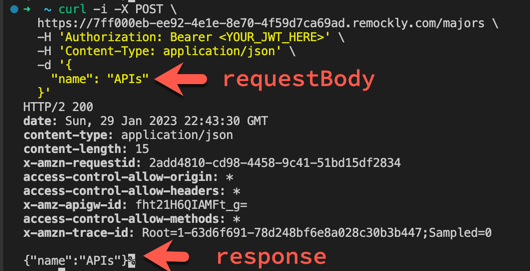
🎉 Woo hoo! You've sent your second API request.
Now, take out those OpenAPI note cards and walk through how you think you would describe this one.
It's pretty much the same cards as the last request with minor changes:
- You don't use the
Parametercard. - You use the
RequestBodycard. - If you pay close attention, you would use the
Headercard to describe the response headers. - You would also use the
SecurityRequirementcard, which means the security scheme needs to be defined, which require theComponentcard andSecuritySchemecard.
Look through these cards and follow the relationships from the Root card onward.
paths:
/majors:
post:
operationId: postMajors
summary: Create a major
security:
- admin: ['admin']
description: Creates a new major (must be approved by the administration).
requestBody:
content:
application/json:
schema:
$ref: "#/components/schemas/major"
responses:
'200':
description: OK
content:
application/json:
schema:
$ref: "#/components/schemas/major"You'll notice the schema has this underneath it: $ref: "#/components/schemas/major". That is a reference object, which allows us to reuse a schema in more than one place. It is common to use reference objects for schemas, parameters, and headers. We'll learn more about those another time.
At this point, the goal is not to know the structure of OpenAPI, but to be able to identify the corresponding types (starting from the Root type) involved in a description.
🎉 Woo hoo! You can identify different types.
The most complex of the types is Schema which is mostly inherited from JSON Schema. JSON Schema has its own specification and there are multiple versions of it too.
In our note cards, Schema takes four cards, where no other type takes more than one card.
And Schema references itself which makes for a lot of complexity.
The most common properties (fields) to know are:
- type
- description
- format
- properties (for objects)
- items (for arrays)
- examples (or example)
- enum
- default
In practice, the most common uses of JSON Schema are much more manageable.
Also, there isn't a strong need to write JSON Schema from scratch. Instead, refine it by adding descriptions, a format, or extra constraints. We have a JSON to JSON Schema tool which can transform a JSON snippet into JSON Schema.
For example, using the request or response from the most recent create a major API, we can copy the following.
{
"major": "APIs"
}And paste it into the tool.
The output for OAS 3.1 with examples is as follows:
type: object
properties:
major:
type: string
examples:
- APIsThe tool is practical. Use it.
🎉 Woo hoo! You've gone from a JSON example to a JSON Schema.
Take out the four schema cards and the root card. Shuffle the remaining cards. Pick one randomly. Identify the parent or parents as quickly as you can.
For example, let's say you pick the RequestBody card.
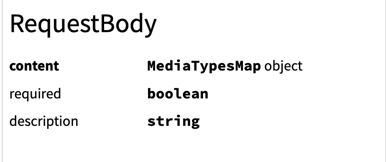
Then, you need to figure out which cards reference the RequestBody object. The Operation object is the parent.
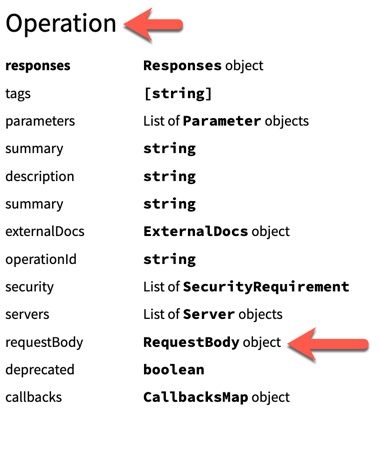
Play this game for 10 minutes.
🎉 Woo hoo! You've got a better sense of the relationships between the data types.
Let's get writing already.
Open VS Code and create a file named cmc.yaml.
Redocly has a VS Code extension (do not install that yet or turn it off for this tutorial). There is one school of thought that learning to ride a bike is better without training wheels. We recommend you install the extension after you complete this tutorial.
🎉 Woo hoo! You made a YAML file! (Okay, it's empty and we can't celebrate this too much yet.)
Pull the Root type card.
Put these in your file.
openapi: 3.0.1
info:
paths:
components:Next: Info card.
When we pull that card, we see that the title and version are required properties. We'll focus on the minimally required fields before we make it a richer description.
Notice the indentation for the title and version in the following example, which is putting your YAML essentials knowledge to the test.
openapi: 3.0.1
info:
title: CMC Majors
version: v1
paths:
components:Next: Paths card.
Let's describe the major popularity first, starting with the path (see /popularity added in the following example).
openapi: 3.0.1
info:
title: CMC Majors
version: v1
paths:
/popularity:
components:Next: PathItem card.
Even though nothing is required, we want to describe the request.
curl -X GET \
'https://7ff000eb-ee92-4e1e-8e70-4f59d7ca69ad.remockly.com/popularity?class=2025'Notice the -X GET which let's curl know to send a GET request. We need to use the get field, as shown in the example.
openapi: 3.0.1
info:
title: CMC Majors
version: v1
paths:
/popularity:
get:
components:It is possible to describe parameters on the path item level or on the operation level. We'll do it on the operation level.
Grab the Operation card and start finding and filling out the fields where applicable. I always fill the summary for an operation.
openapi: 3.0.1
info:
title: CMC Majors
version: v1
paths:
/popularity:
get:
responses:
parameters:
-
summary: Get popularity by major
components: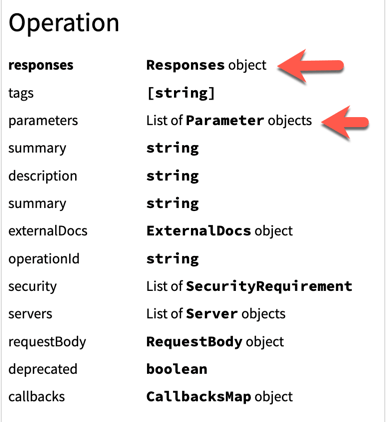
We need the Responses and Parameter cards based on the Operation card.
Let's do the Responses first.
We need the response status code, which means we need to add the -i to the curl request and run it again.
curl -i -X GET \
'https://7ff000eb-ee92-4e1e-8e70-4f59d7ca69ad.remockly.com/popularity?class=2025'You'll see the following in the headers of the response.
HTTP/2 200The "200" is the response status code. Here we've added it to our YAML file. It should look like the following snippet.
openapi: 3.0.1
info:
title: CMC Majors
version: v1
paths:
/popularity:
get:
responses:
'200':
parameters:
-
summary: Get popularity by major
components:We'll look at the Response type card next, and not forget about the Parameter type (we'll come back to it later).
The response type has a description. In this case, the 200 response means the request was OK. We'll use a brief description here. Since we added the -i, we can see there are some response headers, like x-amzn-requestid: 534f1ef3-a62a-49cc-89d0-7a2ebbe67307 where x-amzn-requestid is a header and the : separates it from a value. In this tutorial, we'll describe that one header only. You can try to describe the other headers for extra credit. We won't use links.
openapi: 3.0.1
info:
title: CMC Majors
version: v1
paths:
/popularity:
get:
responses:
'200':
description: OK
headers:
x-amzn-requestid:
content:
parameters:
-
summary: Get popularity by major
components:As of now, we're keeping track of Parameter, Header, and MediaType.
Let's start with Header.
As a note, the content-type is a special header and is described as the map key for the content in the MediaTypesMap.
It looks like we also need the Schema card to describe the header.
openapi: 3.0.1
info:
title: CMC Majors
version: v1
paths:
/popularity:
get:
responses:
'200':
description: OK
headers:
x-amzn-requestid:
schema:
description: ID of the Amazon request
type: string
content:
parameters:
-
summary: Get popularity by major
components:Next we'll describe the content, which has a map key of the content-type application/json.
openapi: 3.0.1
info:
title: CMC Majors
version: v1
paths:
/popularity:
get:
responses:
'200':
description: OK
headers:
x-amzn-requestid:
schema:
description: ID of the Amazon request
type: string
content:
application/json:
parameters:
-
summary: Get popularity by major
components:Grab the MediaType card (and we need the Schema card again too).
Use the JSON to JSON Schema tool to generate a schema and then paste it in paying careful attention to fix indentation as VS Code may automatically change it (I did it without the examples to keep the YAML shorter for this tutorial).
openapi: 3.0.1
info:
title: CMC Majors
version: v1
paths:
/popularity:
get:
responses:
'200':
description: OK
headers:
x-amzn-requestid:
schema:
description: ID of the Amazon request
type: string
content:
application/json:
schema:
type: object
properties:
class:
type: string
breakdown:
type: array
items:
type: object
properties:
major:
type: string
count:
type: integer
parameters:
-
summary: Get popularity by major
components:Next, we'll add the Parameter info. Parameters are a list, so they are prefixed with the - before each parameter (not before each line).
openapi: 3.0.1
info:
title: CMC Majors
version: v1
paths:
/popularity:
get:
responses:
'200':
description: OK
headers:
x-amzn-requestid:
schema:
description: ID of the Amazon request
type: string
content:
application/json:
schema:
type: object
properties:
class:
type: string
breakdown:
type: array
items:
type: object
properties:
major:
type: string
count:
type: integer
parameters:
- name: class
in: query
required: true
schema:
type: string
example: "2025"
summary: Get popularity by major
components:🎉 Woo hoo! You've described an API operation.
This is a great spot to reflect. We've completed describing one operation. The goal is to become more comfortable navigating between the types using the cards.
Let's start on our next operation. Not everyone is able to add a major, and let's describe the security first.
Grab the Components, SecurityScheme, and SecurityRequirement cards. I understand you won't understand so much about API security, so follow along as best you can. There are a lot of ways to secure the API, and we'll use a JWT bearer token.
First, we'll add the components and security scheme named admin.
components:
securitySchemes:
admin:
type: http
scheme: bearer
bearerFormat: JWTThen, we'll be able to register the security requirement when we describe our operation by adding something like the following:
security:
- admin: []Here is our YAML file so far.
openapi: 3.0.1
info:
title: CMC Majors
version: v1
paths:
/popularity:
get:
responses:
'200':
description: OK
headers:
x-amzn-requestid:
schema:
description: ID of the Amazon request
type: string
content:
application/json:
schema:
type: object
properties:
class:
type: string
breakdown:
type: array
items:
type: object
properties:
major:
type: string
count:
type: integer
parameters:
- name: class
in: query
required: true
schema:
type: string
example: "2025"
summary: Get popularity by major
components:
securitySchemes:
admin:
type: http
scheme: bearer
bearerFormat: JWTNow, we'll repeat the steps. This time, I'll do it in bigger chunks of work.
I'll add the path, path item, and operation. Notice that this request is a POST request and uses the post property for the PathItem. I also fill the security as part of the operation. I left the requestBody and responses empty for the next step.
openapi: 3.0.1
info:
title: CMC Majors
version: v1
paths:
/majors:
post:
summary: Add a major
requestBody:
responses:
security:
- admin: []
/popularity:
get:
responses:
'200':
description: OK
headers:
x-amzn-requestid:
schema:
description: ID of the Amazon request
type: string
content:
application/json:
schema:
type: object
properties:
class:
type: string
breakdown:
type: array
items:
type: object
properties:
major:
type: string
count:
type: integer
parameters:
- name: class
in: query
required: true
schema:
type: string
example: "2025"
summary: Get popularity by major
components:
securitySchemes:
admin:
type: http
scheme: bearer
bearerFormat: JWTUsing the JSON to JSON schema tool, we have the same request and response body schema.
The following is an example request and response body.
{
"major": "APIs"
}The corresponding JSON schema follows.
type: object
properties:
major:
type: string
examples:
- APIsNext, we'll complete the description of the RequestBody, Responses, and Response types.
openapi: 3.0.1
info:
title: CMC Majors
version: v1
paths:
/majors:
post:
summary: Add a major
requestBody:
content:
application/json:
type: object
properties:
major:
type: string
examples:
- APIs
responses:
'200':
description: OK
content:
application/json:
type: object
properties:
major:
type: string
examples:
- APIs
security:
- admin: []
/popularity:
get:
responses:
'200':
description: OK
headers:
x-amzn-requestid:
schema:
description: ID of the Amazon request
type: string
content:
application/json:
schema:
type: object
properties:
class:
type: string
breakdown:
type: array
items:
type: object
properties:
major:
type: string
count:
type: integer
parameters:
- name: class
in: query
required: true
schema:
type: string
example: "2025"
summary: Get popularity by major
components:
securitySchemes:
admin:
type: http
scheme: bearer
bearerFormat: JWT🎉 Woo hoo! You've described the other API operation.
That nearly concludes the API description. The schema was copy and pasted in two spots. Instead of doing that, we can reuse a single source of truth. That way, if it evolves it is updated in all places. To do that, we'll use a reference object ($ref). Reference objects could be in different files, or even remote files, or within the same file OpenAPI has a special place for named schemas in components.
The following shows a sample implementation in components named schemas.
components:
schemas:
major:
type: object
properties:
major:
type: string
examples:
- APIsThen, we can adjust our usages.
openapi: 3.0.1
info:
title: CMC Majors
version: v1
paths:
/majors:
post:
summary: Add a major
requestBody:
content:
application/json:
$ref: '#/components/schemas/major'
responses:
'200':
description: OK
content:
application/json:
$ref: '#/components/schemas/major'
security:
- admin: []
/popularity:
get:
responses:
'200':
description: OK
headers:
x-amzn-requestid:
schema:
description: ID of the Amazon request
type: string
content:
application/json:
schema:
type: object
properties:
class:
type: string
breakdown:
type: array
items:
type: object
properties:
major:
type: string
count:
type: integer
parameters:
- name: class
in: query
required: true
schema:
type: string
example: "2025"
summary: Get popularity by major
components:
schemas:
major:
type: object
properties:
major:
type: string
examples:
- APIs
securitySchemes:
admin:
type: http
scheme: bearer
bearerFormat: JWT🎉 Woo hoo! You've use the $ref.
If you've made it this far, you're absolutely cooking.
There is one more API to document regarding athletics.
You can try it with this curl command.
curl -i -X GET \
https://7ff000eb-ee92-4e1e-8e70-4f59d7ca69ad.remockly.com/athletics(I only added my favorite team.)
Remember the process, reference the type cards, and share your YAML file with us. Good luck. And don't forget to install the Redocly VS Code extension.
🎉 Woo hoo! You've done this without guidance on your own.
If you were able to do that, you know OpenAPI good enough to be a productive member of any API team.
If you were not able to complete the description, don't despair. First, we're trying to cram a whole "semester" of information into a day. Second, this is a first draft blog post that definitely needs some revisions. I'd love feedback on where you got stuck.
Next you'll learn what you can do with OpenAPI tools, such as rendering docs for APIs.
